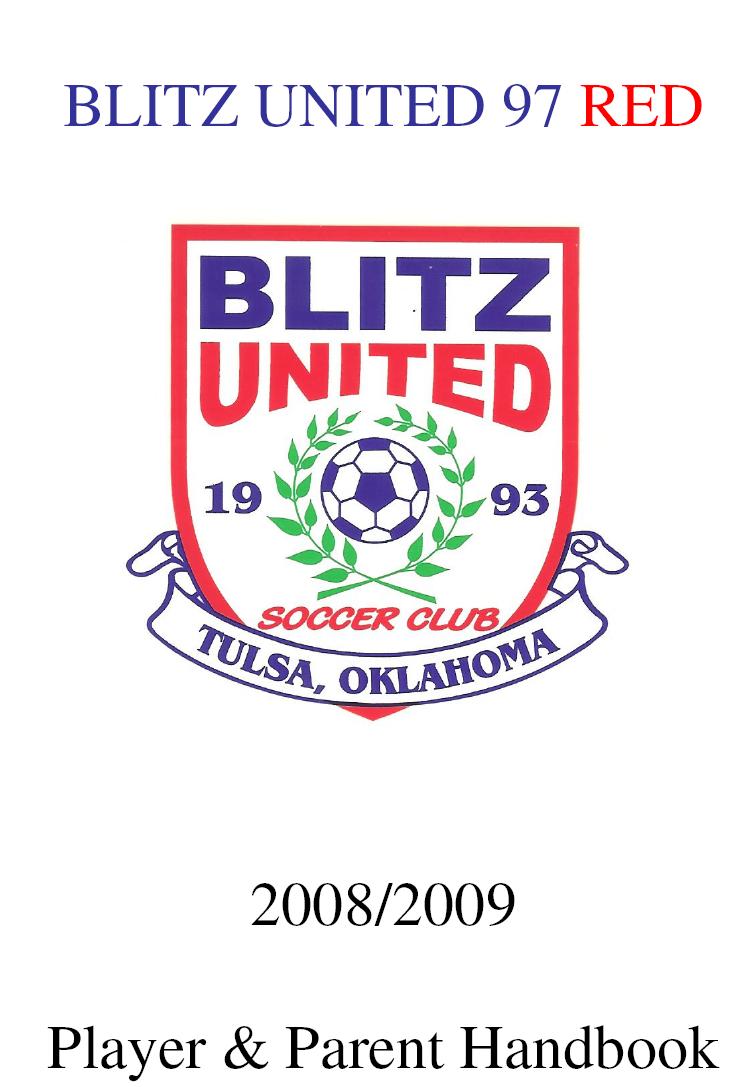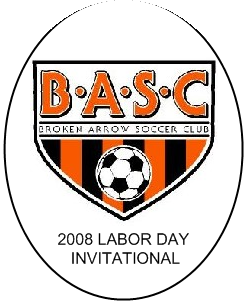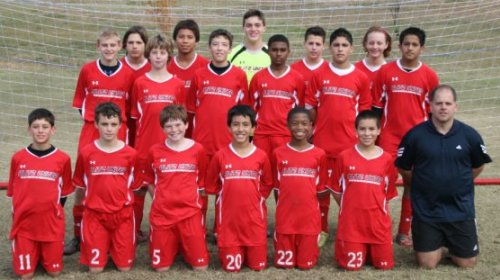 Blitz '97 Red
Blitz '97 Red
Achievements
2009/2010
2009 Blitz United Under Armour Fall Invitational
Champions
2008/2009

Gold Division
Finalists
2007/2008

OK President's Cup
2008
Champions
Champions Challenge 2008
3rd Place
Blitz Fall Invitational 2007
Semi-finalists
BASC Labor Day 2007
Semi-finalists
Beat the Heat 2007
Semi-finalists
Principles of Play
Taken From EZINE ARTICLES:
These principles
- Have remained the same for as long as the game has existed, even though we may not have know it at the time.
- Apply to the game regardless of different systems of play and the different formations played by teams
- Will withstand the evolution of the game
- Will always apply regardless of whether your team, or the opposition team plays a 4-4-2 system or a 3-5-2 system or a 4-3-3 system.
In fact the principles of play are vital in coaching because
understanding them will make it far easier to deal with and exploit
variations in formations and systems of play that you will encounter
from opposition teams.
The principles of play are divided into 2 catagories
- Attacking Principles
The attacking principles apply when our team has the ball is is looking to:
- Keep possession of the ball
- Move the ball forward into an attacking position
- Create chances to score a goal
- Defending Principles
Conversely, the defending principles apply when the opposition has the ball, and our team needs to:
- Prevent the opposition from creating a chance to score a goal
- Limit the opportunities for the opposition to get into attacking positions
- Regain possession
Attacking Principles of Play
When your team has the ball, the Attacking Principles apply, regardless
of the position that the ball is on the field. The five principles of
that govern play when you are attacking are:
- Penetration
- Depth
- Width
- Mobility
- Improvisation
The following discusses the various roles and tasks that players have
to follow the attacking principles
Attacking principle - role of the 1st Attacker to achieve
penetration, use improvisation and maintain possession
When our team has the ball, the first and foremost objective is to achieve
penetration, that is move the ball forward. The ultimate penetration
is of course having a shot and scoring a goal, but how do we get to
that position.
The 1st attacker (the player with the ball) should attempt to attack
the space behind the defender.
This can be achieved in a number of ways, and does depend on where
abouts on the field you have the ball.
- Shooting
- Dribbling past a defender
- Passing the ball befind a defender to a 2nd attacker and immediately offering support to that player
- Putting the ball and youself into the space behind the defender, either by a pass to youself or a wall pass
- Looking to run at angles to get behind the defender
It may be necessary to create space behind the defender to exploit that space.
Create space behind the defender by
- Commiting the defender to challange
- Enticing the defender forward and thereby creating space behind the defender
The 1st Attacker is also required to keep possesion of the ball
- Keep the ball moving and away from the defenders range
- Take the ball away from the defenders feet with your first touch
- Move the ball into space, and improvise to trick defenders into moving the wrong way
Attacking principle - role of the 2nd Attackers to provide
depth and width
The 2nd attacker(s) are the players in the immediate vicinity of the 1st
attacker. The role of the 2nd attacker(s) is to try and achieve depth
and width by providing a supporting role.
The role of the 2nd attacker(s) is to help the 1st attacker by:
- Supporting at various distances within the visual range of
the 1st attacker.
- Giving the 1st attacker a number of options and the
1st attacker should look to get the ball forward as much as
possible
- Giving the 1st attacker a good angle and clear line to pass
the ball. When Receiving the ball the support player must be
positioned to play the ball in the desired direction (usually
forward) with their first touch. This is normally done by the
receiving player having an open stance.
- If the 1st attacker is attempting to dribble past the
defender, the supporting players help by moving away from the
1st attacker, and thereby enticing the 2nd defender away from
their supporting role
- The supporting attackers should be in constant communication
with the 1st attacker, letting them know of any dangers, or
options that the 1st attacker is not aware of.
Attacking principle - role of the 3nd Attackers to provide mobility,
depth, width and penetration
the 3rd attacker(s) are other attackers that are away from the
immediate playing area. 3rd attackers provide a supporting role to the
1st and 2nd attackers in a number of ways to ensure that the principles
of play are being followed.
- Make runs on the blind side of defenders
- Attacks the space behind the defenders without the ball
- Runs away from defenders which can have 2 outcomes
- The defender follows the attacker and so space is created behind the defender
- The defender does not follow the attacker, so the attacker is now free
- Runs that are made with no intention to receive the ball must be encouraged as much as runs to receive the ball
- Commit the last defender byrunning past them and distracting them
- Entice 3rd defenders away and thereby creating space
The timing of runs is vital
- Running to create space the run is made early
- Running to exploit existing space the is made late
Defending Principles of Play
Conversely, when the opposityion has the ball, the Defending Principles
apply,again, regardless of the position that the ball is on the field. The
five principles of that govern play when you are defending:
- Delay
- Depth
- Balance
- Concentration
- Control/Restraint
The following discusses the various roles and tasks that players have
to follow the attacking principles
Defending - role of the 1st Defender to win the ball or delay the opposition
When the opposition has the ball, the first and foremost objective is
to regain possession. The player with the ball is the most dangerous
opponent and should always be the focus of the 1st defender
Roles of the 1st defender (the defender closest to the ball and usually goalside) .
- Must focus on the ball and the 1st attacker
- Wins the ball or delays penatration
- Stops or delays the opponent playing the ball forward
- Reduces the opponent space by applying pressure quickly
- Show the opponent the way that the 1st defender wants the attacker to go
- Applies a tackle to the opponent when there are supporting defenders
- Stays on their feet in a balanced and ready state, focussing on the ball
Defending principle - role of the 2nd Defenders to provide
depth, concentration and mobility
The 2nd defenders(s) are the players in the immediate vicinity of
the 1st defender. The role of the 2nd defender(s) is to provide a a
supporting role.
The role of the 2nd defender(s) is to help the 1st defender by:
- Cover and support quickly
- May have to mark the supporting attackers. Note the 1st
attackes body shape will dictate where the 2nd defender should
concentrat the support.
- Always looking to
- apply double pressure to the player with the ball
- apply pressure to the next opponent that is able to receive the ball
- The supporting defender(s) should be in constant communication
with the 1st defender, letting them know of any dangers, or
options that the 1st defender is unaware of.
Defending principle - role of the 3rd Defenders to provide
concentration, mobility and communication
The 3rd defender(s) are other defenders that are away from the
immediate playing area. 3rd defender(s) provide a supporting role to the
1st and 2nd defenders in a number of ways to ensure that the principles
of play are being followed.
- Tracking down opponents that are making forward runs
- Do not allow opponents to get goalside of them
- Always prepared to balance the defence
- Always prepared to become 1st or 2nd Defenders INSTANTLY
- Always scanning the field and supllying communication
- Always looking for intereptions
- Always looking to apply pressure to the next play that is able to receive the ball
Apply tight marking so the opponent cannot score with the 1st touch
